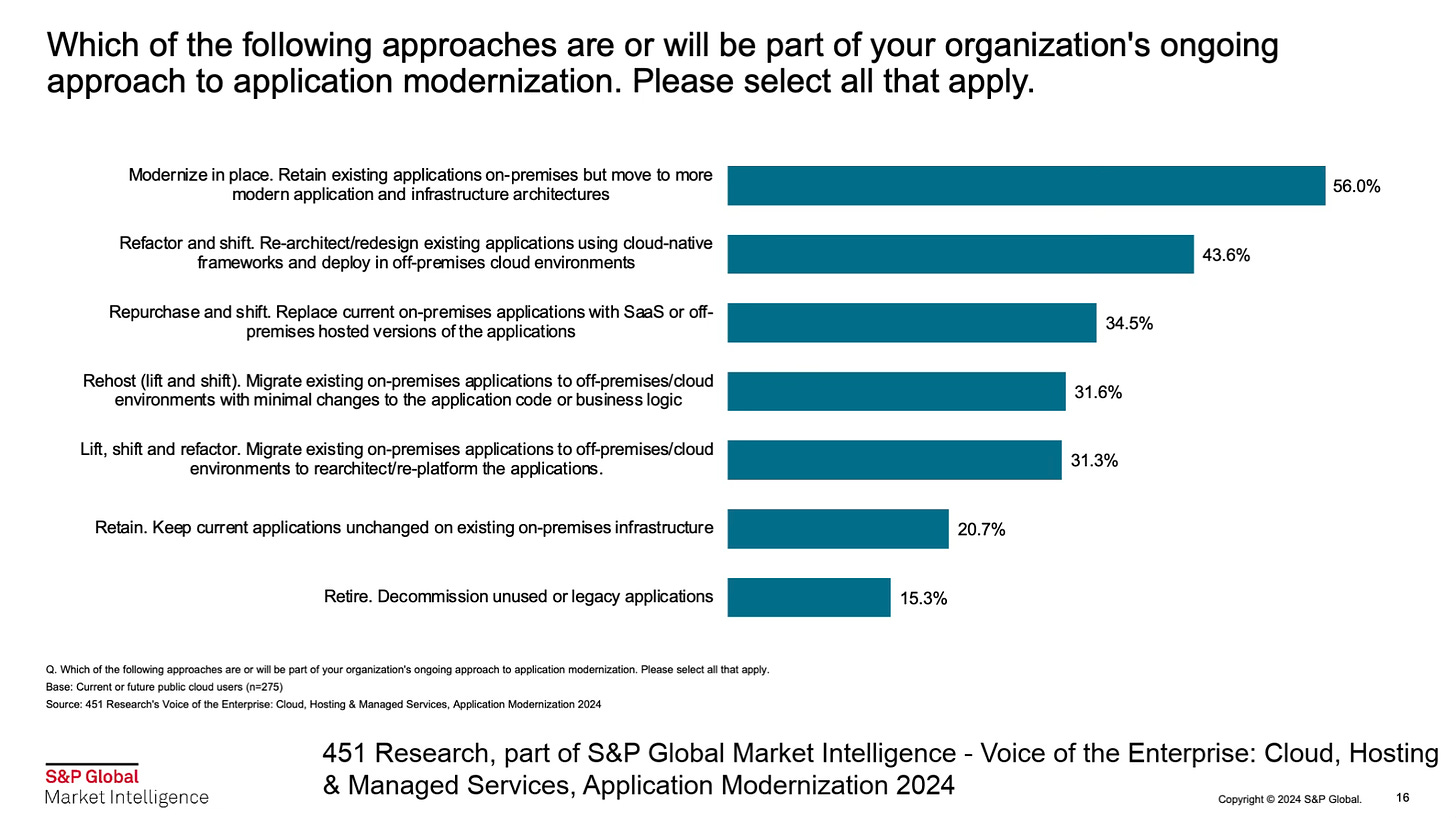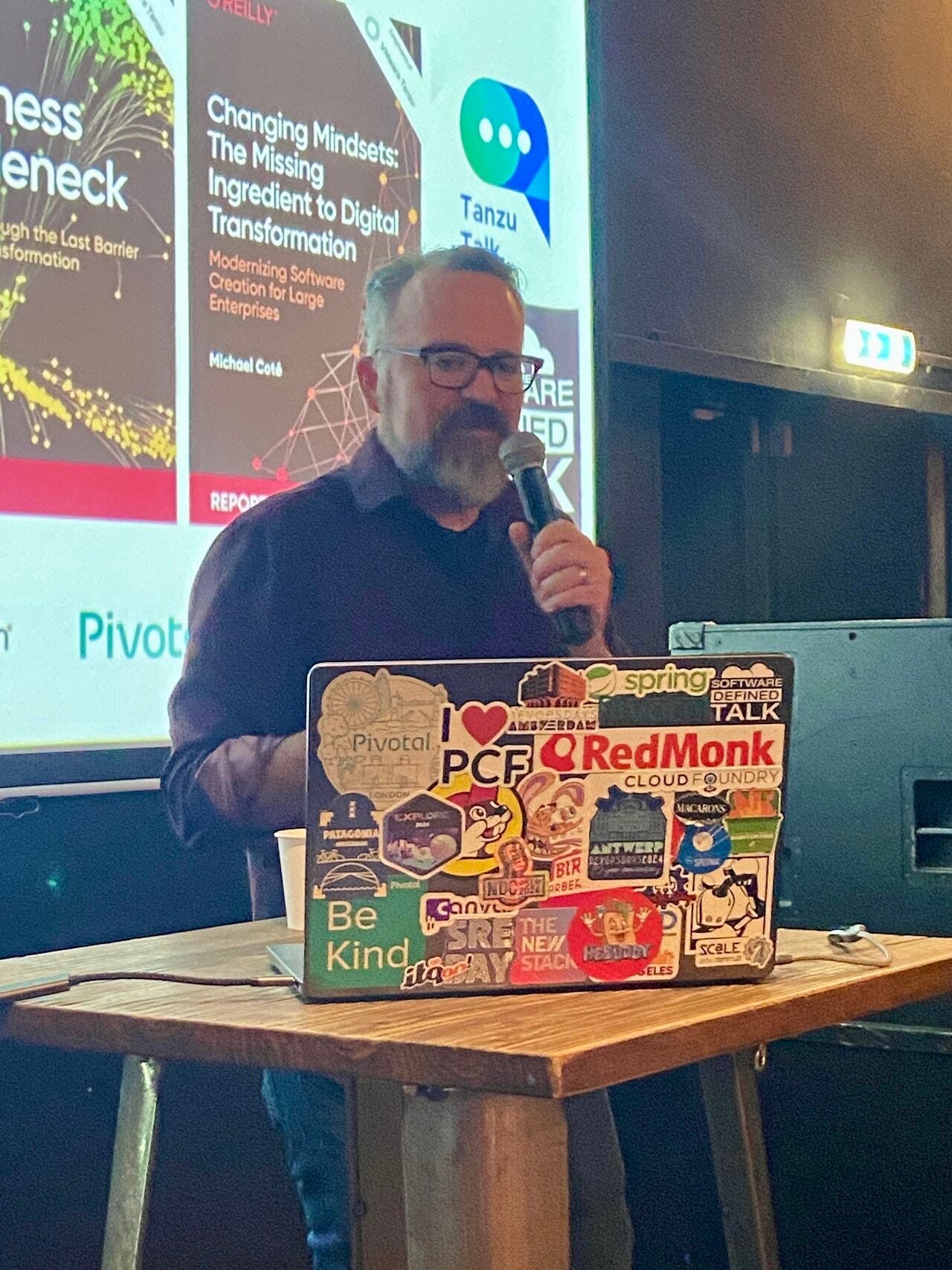Coté
Strategy is Not War; It’s Gardening - Post Sun Tzu strategy metaphor.
Modern Work Fucking Sucks. - Attack of the SaaS productivity apps. // Maybe it’d be better to just use one suite of tools: Office 364 or Google Apps, i.e., the #defaultslifestyle. // It’s easy to fall into the habit of planning and showing progress in work instead of just doing the work.
Where do modernized apps go to live?
Where are people putting their modernized apps? Here’s a recent survey chart on that topic from 451:
Recent Content
Three things for you today:
The private cloud equilibrium - my most recent attempt to figure out how much private cloud is out there.
Platform Engineering and UK Digital People, with Abby Bangser - this week’s Software Defined Interviews: As if platform engineering and expat'ing in the UK weren't enough, Whintney and Coté discuss the forgotten technology of business cards wih Abby Bangser.
The most honorable of mentions - This week’s Software Defined Talk: we discuss the relationship between DevOps and Platform Engineering, Gartner’s take on Distributed Hybrid Infrastructure, and Nvidia’s search for new use cases. Plus, a listener chimes in to clear up some Podman misconceptions.
Relative to your interests
DORA Report 2024 – A Look at Throughput and Stability - Developer productivity is fine, but: “We thought the bottleneck was developers writing code, but in fact the bottleneck is putting good code into production.” // Maybe the current trend in DevOps/platform engineering/cloud native to to stop caring about developer productivity, rather, re-silo and let them care about it, and instead focus on operations productivity. Definitely that re-eval of how silo-busting has been going. https://redmonk.com/rstephens/2024/11/26/dora2024/
The Rise of AI Agent Infrastructure - We’re all figuring out what “agent” means in AI land. It’ll probably end up meaning nothing if us marketing people do our jobs of claiming that we all do it.
AI is reshaping call center work in the Philippines - ‘“AI is not to replace people but to help people become more productive,” she said. “If you needed 10 team members before, maybe now you only need five.”’ // Hmm, those two statements don’t seem to go together.
China tech tariffs: Which countries will be affected - Round up of how current tariffs are going, and what they are.
Rewiring the way McKinsey works with Lilli, our generative AI platform - “30% time savings in searching and synthesizing knowledge.” // Worth reflecting on how much of this is pulling together all the stuff for monthly status updates to management, a huge time suck for office workers. Much of it is probably bullshit work, but why not let the bullshit artist do it?
Magic Quadrant for Distributed Hybrid Infrastructure - I’d call this something more like “multi-cloud platform.” A sub-set is cloud native, Kubernetes, really. A further subset is private cloud. As always with critiquing Gartner work, unless you have full access to related PDFs and have read them, be careful with assumptions and scorn.
Logoff
Not much this episodes! I’ve recorded 6 podcasts this week, with one more coming this afternoon. I’ve also been working on that same internal video for our Sales Kick-off. You could say I’m multi-media brain-dead. Still, it’s been fun having “content” to focus on with little time to do so: it allows me to ignore all the daily bullshit work.1 Perhaps there’s something to learn there! Of course, it being Thanksgiving week in the US helps: most people are also ignoring daily bullshit work.
//
Just two more weeks left in my work-year. How did this last year go? My work made a dramatic shift in strategy, focusing just on private cloud. This is probably good.
I didn’t speak at as many conferences as I usually do. I do a little bit more internal facing work, and I’ve done a lot more “on brand” work. This is sort of weird. I’ve run out of things to say at conferences.
Since platform engineering decided to murder DevOps and just start that whole thing over from scratch, the conversations has turned into the same old shit we’ve been talking about since at least 2015. I spent a lot of 2022 and 2023 saying as much. It gets really, really boring talking about “how to do software better” over and over after 10 years, especially when the industry decided to reboot it. It’s like watching a really shitty remake of a classic movie you grew up with. This means it’s difficult for me to come up with anything interesting and entertaining to say.
Nonetheless, I had a few new talks - arguably just twists and updates on the same old shit, but fun to do nonetheless. I have one new talk that’s been accepted for new year building on my ongoing hunt for coverage of private cloud usage. And if the KubeCon London 2025 people are into it, there’ll be a new panel.
Now, listen, in all honesty I have very little of this type of work foisted upon me. Most of it is self-assigned and driven by my habit of walking around he visual hallways at work and sticking my nose into other people’s business.
DORA Report 2024 – A Look at Throughput and Stability - Developer productivity is fine, but: “We thought the bottleneck was developers writing code, but in fact the bottleneck is putting good code into production.” // Maybe the current trend in DevOps/platform engineering/cloud native to to stop caring about developer productivity, rather, re-silo and let them care about it, and instead focus on operations productivity. Definitely that re-eval of how silo-busting has been going.
The Rise of AI Agent Infrastructure - We’re all figuring out what “agent” means in AI land. It’ll probably end up meaning nothing if us marketing people do our jobs of claiming that we all do it.
AI is reshaping call center work in the Philippines - Rest of World - ‘“AI is not to replace people but to help people become more productive,” she said. “If you needed 10 team members before, maybe now you only need five."’ // Hmm, those two statements don’t seem to go together.
China tech tariffs: Which countries will be affected - Round up of how current tariffs are going, and what they are.
Rewiring the way McKinsey works with Lilli, our generative AI platform - “30% time savings in searching and synthesizing knowledge.” // Worth reflecting on how much of this is pulling together all the stuff for monthly status updates to management, a huge time suck for office workers. Much of it is probably bullshit work, but why not let the bullshit artist do it?
Magic Quadrant for Distributed Hybrid Infrastructure - I’d call this something more like “multi-cloud platform.” A sub-set is cloud native, Kubernetes, really. A further subset is private cloud. As always with critiquing Gartner work, unless you have full access to related PDFs and have read them, be careful with assumptions and scorn.
There is no open source business model. It's always about selling something that's closed source, or, at least, proprietary
Open Source $$$ Ethics, How Analysts use AI, Advanced Chicken Nugget Diplomacy, with Rachel Stephens
In this episode of Software Defined Interviews, Whitney Lee and Coté dive into the insights of Rachel Stephens from RedMonk about the world of being an industry analyst. They discuss experiences from working as an analyst, the balance between qualitative and quantitative analysis, the challenges and misconceptions surrounding open-source business models, and the impact of AI on the analyst profession and beyond. They also discuss the 2024 DORA report, and a few other topics.
If you listen to podcast, you should subscribe to this one.
Relative to your interests
Business spending on AI surged 500% this year to $13.8 billion, says Menlo Ventures - “The report found code generation is the leading use case for generative AI, with more than half of survey responses naming that as a dominant use. Support chatbots came next, at 31%, followed by enterprise search and retrieval, data extraction and transformation, and meeting summarization.” // Once enterprise people are comfortable with using public cloud AI (they are currently not, at scale) things will grow a lot. Then we’ll need a year to see if it’s actually useful (and worth, like, $20 a month per head more in the IT bill). I hope it works! I like the AI stuff.
Platform Engineering Is The New DevOps - “Once hailed as the savior of organizational dysfunction, DevOps is causing friction in teams finding that operations is work they never really wanted to do. To get back to a happier balance, DevOps teams are finding that platform engineering helps them to split out operations from application development so that each function can return to focusing on what they do best.” // Way back when, Andrew Shafer would explain that the “you write it, you run it” thing only works if you have a highly automated platform. He still goes over that of course. His point there is one of the most often forgotten parts of all the cloud stuff over past years. Worse is when you have lots of platforms or set the layer of your platform too low, usually at the IaaS layer. You need a centralized PaaS. People are difficult in change, but technology is hard as well, especially if you have the wrong technology or haven’t changed it to match, help, and embody the new way you want to work (“culture”).
New York Times & AWS dispel three mainframe migration myths - What’s most shocking is that the New York Times had a mainframe. But, I guess it’s old enough that of course they do.
The Future Of B2B Buying Will Come Slowly … And Then All At Once - “Six months later, a little more than 18 months after ChatGPT launched, we polled B2B buyers for the first time about whether they are using generative AI. The genAI adoption numbers were shocking. The overwhelming majority, 89% of buyers in Forrester’s Buyers’ Journey Survey, 2024, reported that they were using genAI in at least one area of their purchasing process.”
Best non-fiction of 2024 - List of books.
Marketing from jdilla.xyz - “If you try and tell people 5 interesting things about your product / company / cause, they’ll remember zero. If instead, you tell them just one, they’ll usually ask questions that lead them to the other things, and then they’ll remember all of them because it mattered to them at the moment they asked. Modern social media rewards information abundance, so if you find yourself with a product / company / cause that has lots of benefits, tell each of those story one at time. People are more likely to remember it and it gives you more to post.”
Managing managers is its own skill - “I remember when a new executive was brought in to Freddie Mac at a high level in the IT department. My colleague Mary pointed out to me that he did not bring anyone with him from his former position. She saw that as a bad sign, suggesting that he had not earned much respect from his managers at his former employer. She was proven right, and he soon was bounced out of his position at Freddie Mac.”
THE RIGHT PEOPLE - Driving subscribers: “Write a post that will resonate with the person you’re emailing. Yes, even if it’s just that one person. Email the person the link. Maybe they subscribe, or at least reply and you two catch up, and who knows where that leads?”
AWS named as a leader again in the Gartner Magic Quadrant for Distributed Hybrid Infrastructure - AWS, VMware, Azure, Oracle, and Nutanix are in the MQ leader’s quadrant for “hybrid cloud.”
Wastebook
“Individual non-contributor.”
I’m pretty sure that I had a dream last night that I could easily buy SPY in my US brokerage account. For some reason, living abroad, I can’t do that. Taxes? Small print for liability reasons? Who knows, who cares. The thing is, I could probably call the brokerage and find out what to do. I am somehow horrified of calling them - just the conversation, just calling someone. What an odd, paralyzing phobia. This applies to almost every other business/consumer relationship I have. How do I get over that? I see other people who are totally fine just calling whoever - sometimes they’re the person hoarding a plane and talking on their phone. What thought-technology are these people benefitting from that I’m not?
I did the math tonight and I realized I’ve worked in computers for 29 years.
Related: Kid, I’ve got dotfiles older than you.
Why have the Dutch not come up with kruidennoten ice cream? It’d be like the Blue Bell buñuelos of the Netherlands.
I bet this is a great panel from KubeCon. Packed with banks.
Brevity is the soul of corporate comms confusion.
“Please cease the vibing and chilling or we will swallow a battery.” ArcaneBullshit.
“Bitter,” as in “they’re a very bitter person,” isn’t used much anymore. Now’s probably a time to put it back into the daily lexicon.
“The industry keeps moving, even if I’m in all-day meetings.” Link-blogger powerhouse Seroter.
“I’m sure we’d all agree that McDonald’s do not make the finest hamburgers on the planet. On the other hand, if you want a Big Mac, then a Big Mac is what you want — and no amount of boutique sliders fashioned from Kobe beef and hand-seasoned by elves is going to hit the spot.” From fellow Big Mac fan.
Logoff
The Software Defined Interviews podcast reboot is going real well, see above! Whitney is a natural at podcasting and she and I don’t overlap too much in, I don’t know, the conversations we want to have and takes. That makes for a whole new type of conversation than if it was just me or with my usual bunch. We have a lot of recordings this week which we’ll drip out every two weeks. You should subscribe to it and listen, of course. I don’t really “get” subscribing to YouTube as a podcast (I think you just subscribe to the channel?), but here’s the playlist of the video versions of our recordings.
//
As I mentioned, I’m working on an internal video. Five minutes for the annual sales kick-off going over what Tanzu is. Normally, I loath spending too much time on video content, well, any content, really. I suppose there’s hubris crossed with laziness: I think my “first takes” are good enough, and I believe in abundance over perfection.
That’s not how working on an internal video that represents your business unit works, though. I think I’m OK with the fine tuning, reworking, reshooting, and collaborative editing.
Most of it (being OK with it) I guess, is that the intention is to have it be in my gonzo style. Also, I’ve tried to think of the first few video recordings as draft to get people thinking and extract the content - what they want me to say - from the group.
Extracting that content is part of the process. It’s also, in the last few years, where I’ve found myself in marketing. I get involved in work that isn’t about translating the official marketing strategy, talking points, positioning, messaging - you know, the official point of view, “what to say” - into content. It’s about figuring all of that out, coming up with the stuff.
There’s usually so much rigor, discipline, and being on message with corporate marketing that he lack of “what to say” can seem bad, negligent even. But, I mean, that official marketing-talk has to be created somewhere.
The point being, if you work in marketing, you have to watch out for this switch. That applies to all sorts of work, actually. Sometimes you’re asked to follow he strategy, sometimes you’re asked to help come up with it.
(This is especially true when you’re working on corporate strategy. So often when I was doing that at Dell for software and cloud I waned to [and did!] ask “just tell me what you want, dear scatterbrained, changing what you ask for every meeting, executives!” but that wasn’t the job. It was to help them figure out what they wanted.)


